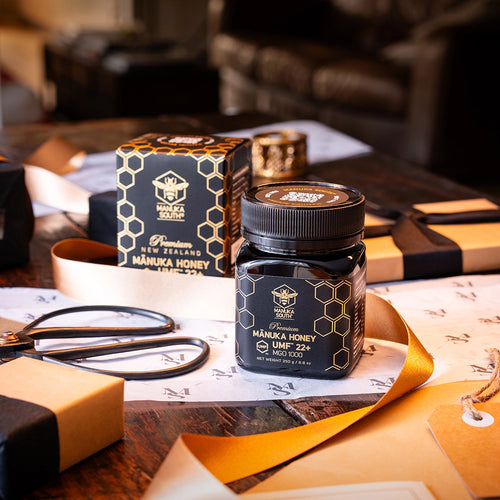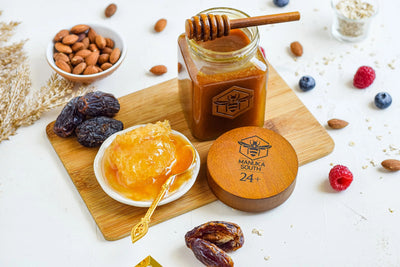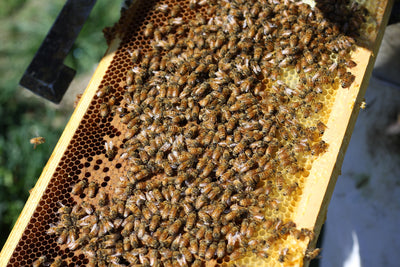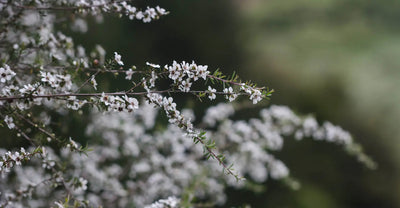Manuka Honey Science
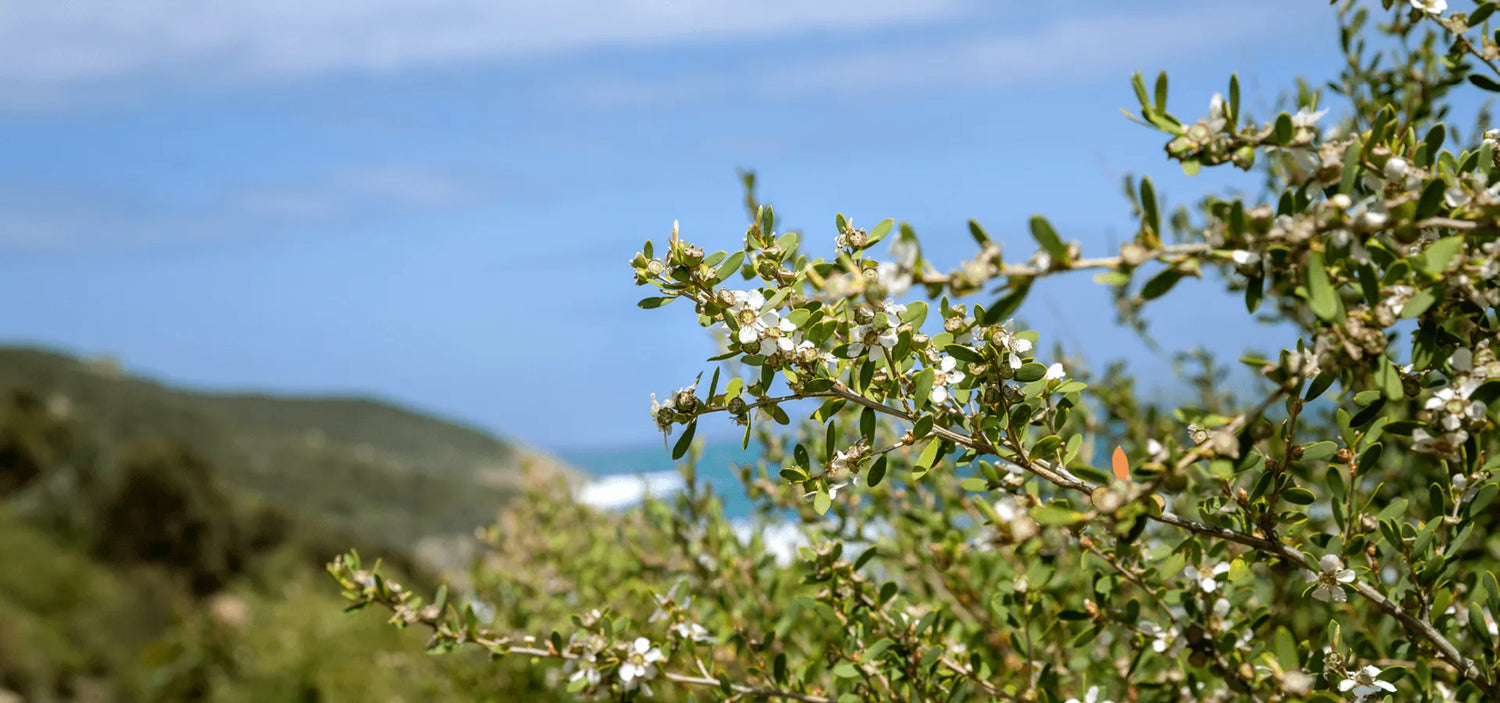
Leptospermum scoparium commonly known as Manuka is a prolific scrub-type tree found throughout New Zealand. It is a hardy tree that can grow in any of New Zealand's microclimates and is often one of the first species to grow after a fire or when the land has been cleared.
However, this robust plant secretly holds many natural benefits to improving our health.
Inside this article about: The Science Behind Manuka Honey
Nature's Medicine
The harvesting of Manuka honey is unlike any other tree as the Manuka bush only flowers for 4-6 weeks each year during the summer, during which beekeepers work very hard during this period to ensure we get a premium Manuka honey harvest.
The biggest impact on our harvest is mother nature, as rain and cold weather can ruin an entire manuka honey harvest. If the weather is bad during flowering, then the bees cannot harvest nectar from the Manuka bush and will instead eat the honey in the hive.
The worker bees' jobs are collecting nectar, pollen, and water, making honeycomb, taking care of larvae, and caring for the queen. The worker bees even regulate the temperature within the hive to 34 degrees centigrade, and will not let the hive temperature fall below 7 degrees.
Worker bees collect nectar and put it in the honey sac. While in the sac, it mixes with enzymes and proteins, which turns the nectar into honey. The honey is then stored in honeycomb where it thickens as the bees fan it with their wings to reduce the moisture content.
Read more: Where does Manuka Honey Come From?
Discovering the Magic
Dr. Peter Molan was a talented Internationally recognized New Zealand biochemist, most known for his studies into the medicinal properties of Manuka honey. In 1981 Molan began to investigate the antiseptic properties of Manuka honey and its use as a dressing to heal wounds. His research identified that Manuka honey has significant non-peroxide antimicrobial activity.
Recent research confirms Dr. Molan’s work, that harmful bacteria are unable to develop resistance against the antibacterial activity of Manuka honey. With antibiotic-resistant bacteria now being a major problem in communities and hospitals, manuka honey can possibly help provide a solution to these acquired infections where options for treatment are very limited.
Manuka honey with high non-peroxide activity is proving to be the most versatile antibiotic available to medicine for combating difficult persistent infections. It has amazing potency against harmful bacteria and yet, surprisingly, it assists in restoring the balance of good bacteria in our bodies according to Dr. Molan.
Manuka honey with high non-peroxide activity is proving effective against subcutaneous infections, e.g. acne and sinusitis. Many studies are being undertaken to understand how the bioactivity can work within the body and why it could have a major role to play in digestive health and for its anti- inflammatory properties.
Manuka Honey's Health Benefits
Manuka honey, native to New Zealand, is celebrated for its potent antibacterial, antiviral, and anti-inflammatory properties, primarily due to its high Methylglyoxal (MGO) content. These attributes make it effective in promoting wound healing, enhancing oral health, soothing sore throats, and supporting digestive health. Additionally, Manuka honey is beneficial for various skin conditions, such as acne and eczema.
When selecting Manuka honey, it's crucial to consider the Unique Manuka Factor (UMF) rating, which indicates its quality and potency. A UMF rating of at least 15+ is recommended to ensure therapeutic benefits. However, individuals with bee allergies, diabetes, or infants under one year should exercise caution and consult a healthcare provider before using Manuka honey.
Read more: The Health Benefits of Manuka Honey
Authentic and Potent UMF Certified Manuka Honey
The Definition of Mānuka Honey
The test for multifloral Manuka honey requires all the 5 attributes in Test 1 and Test 2. If the honey fails to meet one or more of the attributes, it is not considered Manuka honey.
Test 1 Chemical test
The following chemicals all need to be present and at these levels:
- 3-phenyllactic acid at a level greater than or equal to 20 mg/kg but less than 400mg/kg
- 2’-methoxyacetophenone at a level greater than or equal to 1mg/kg
- 2-methoxybenzoic acid at a level greater than or equal to 1mg/kg
- 4-hydroxyphenyllactic acid at a level greater than or equal to 1mg/kg
Test 2 DNA test
This test measures the DNA level of Manuka pollen in the honey to confirm its authenticity. The honey must have a DNA concentration of less than Cq 36 , which is approximately 3 femtograms (fg) of DNA per sample. The "Cq" value refers to the cycle threshold in quantitative PCR testing, which detects the presence of Manuka pollen DNA. If the DNA levels exceed Cq 36, the honey does not have enough Mānuka pollen to qualify as genuine Mānuka honey.
Both tests must be passed for the honey to be certified as Manuka honey. If the honey fails any of the chemical markers in Test 1 or the DNA threshold in Test 2, it is not recognised as Manuka honey.
UMF Laboratory Testing
Manuka honey, native to New Zealand, is renowned for its unique health benefits, largely due to its antibacterial properties. The Unique Manuka Factor (UMF) is a globally recognised grading system that certifies the purity and potency of Manuka honey. It assesses the concentration of key compounds, including Methylglyoxal (MGO), Dihydroxyacetone (DHA), and Leptosperin, which are responsible for the honey's distinctive qualities.
The UMF rating ranges from UMF 5+ to UMF 35+, with higher numbers indicating greater concentrations of these beneficial compounds. For example, a UMF 10+ rating signifies a minimum of 261 mg of MGO per kilogram, while UMF 15+ corresponds to at least 514 mg/kg.
To ensure authenticity, consumers should look for the UMF trademark on the label, which confirms that the honey has been tested and certified by the Unique Manuka Factor Honey Association (UMFHA). Additionally, genuine UMF Manuka honey is produced, packed, and labelled in New Zealand, often featuring a batch number that allows tracing back to its source.
The UMF grading system provides a reliable measure of Manuka honey's quality and potency, helping consumers make informed choices about this exceptional natural product.
Read More: Complete Guide to UMF Manuka Honey
Understanding Manuka Honey Grading Systems
Understanding the various grading systems for Manuka honey is essential for making informed purchasing decisions. These systems assess the honey's quality, purity, and potency, providing consumers with valuable information about its beneficial properties. However, not all grading systems are equally reliable.
The Unique Manuka Factor (UMF™) is widely regarded as the most comprehensive and trustworthy grading system. It evaluates multiple chemical markers, including Methylglyoxal (MGO), Dihydroxyacetone (DHA), and Leptosperin, to ensure the honey's authenticity and effectiveness. This rigorous assessment offers a thorough measure of Manuka honey's health benefits.
In contrast, other grading systems like MGO focus solely on the concentration of Methylglyoxal, providing a narrower view of the honey's properties. Additionally, proprietary systems such as KFactor and BioActive may not measure the unique antibacterial strength that distinguishes Manuka honey, potentially leading to misleading claims.
By familiarising yourself with these grading systems and prioritising those that offer a comprehensive evaluation, such as UMF™, you can confidently select high-quality Manuka honey that delivers the desired health benefits.
Read more: Comparing Manuka Honey Grading Systems
Sources
Further Reading

